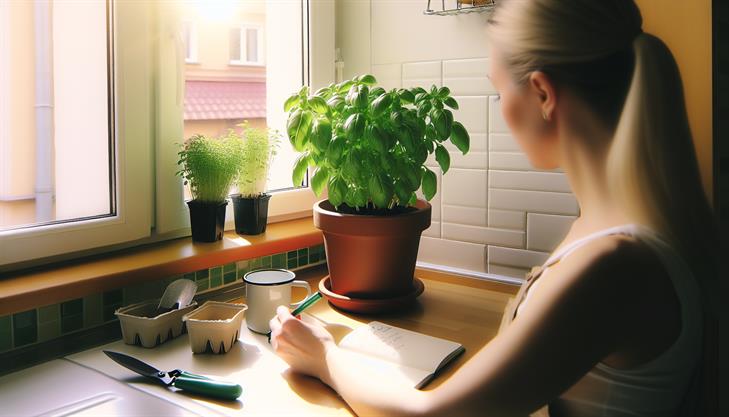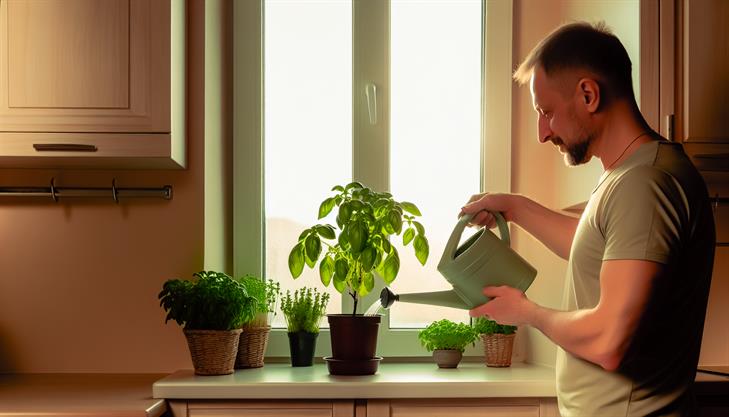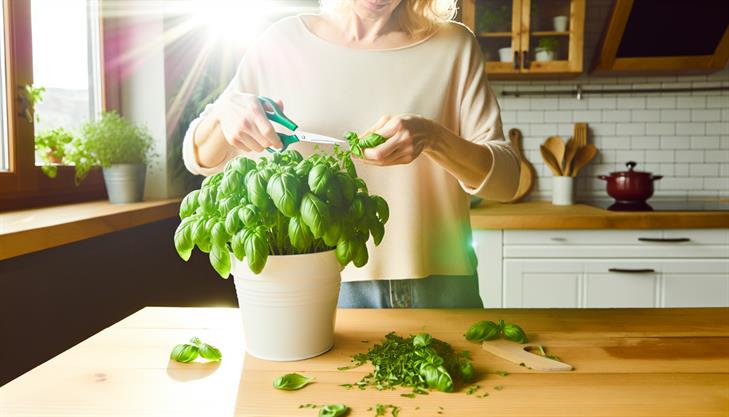Imagine the tantalizing aroma of fresh basil wafting through your kitchen, instantly elevating your cooking from ordinary to gourmet. As one of the most versatile and beloved herbs, basil is a must-have for any culinary enthusiast. But here’s the catch: if you’ve ever tried to nurture a basil plant indoors, you might have found it more challenging than expected. From wilting leaves to stunted growth, indoor conditions can present unique challenges that make keeping basil happy and healthy seem almost elusive.
Caring for a basil plant indoors isn’t just a matter of convenience—it’s a delightful way to ensure you always have this aromatic herb at your fingertips, ready to add a burst of flavor to your dishes. Plus, with the right guidance, growing basil inside your home can be a remarkably fulfilling experience, contributing to a lush indoor garden and enhancing your living space.
In this comprehensive guide, we’ll unravel the secrets to successfully nurturing basil indoors. Whether you’re a seasoned green thumb or a curious beginner, you’ll discover practical tips, expert advice, and common pitfalls to avoid, all aimed at helping you cultivate vibrant, flavorful basil throughout the year. Dive in and unlock the potential of your indoor herb garden today!
Choosing the Right Pot and Soil for Your Basil Plant
Growing basil indoors can be a delightful way to enjoy fresh herbs year-round. To ensure your basil plant thrives, selecting the right pot and soil is crucial.
Choosing the Right Pot
-
Size and Material: Start with a pot that’s at least 6-8 inches in diameter with good drainage holes to accommodate the root system and prevent waterlogging. Ceramic, clay, or plastic pots are all suitable options, but clay pots are great for their breathability, which can help prevent root rot.
-
Drainage: Ensure the pot has ample holes at the bottom to allow excess water to escape. You can place a saucer beneath to catch any drips, which will help keep your indoor surfaces dry.
Selecting the Best Soil
-
Quality Potting Mix: Use a high-quality, well-draining potting mix. A blend designed for herbs is ideal, but you can also enhance regular potting soil with perlite or coarse sand to improve drainage and aeration.
-
Nutrients: Basil thrives in nutrient-rich environments, so consider mixing in a slow-release fertilizer or organic compost to provide a steady supply of nutrients.
Caring for Indoor Basil
-
Light Requirements: Place your basil plant in a sunny windowsill that receives at least 6 hours of sunlight daily. If natural sunlight is limited, supplement with a grow light, positioning it about 2-4 inches above the plant.
-
Watering: Basil prefers consistently moist soil but does not tolerate soggy conditions. Water when the topsoil feels dry to the touch, and ensure excess water drains away. Overwatering is a common issue that can lead to root rot.
-
Temperature and Humidity: Maintain a warm indoor environment with temperatures between 70-80°F. Basil likes humidity, so misting the leaves occasionally or placing a small humidifier nearby can be beneficial.
-
Pruning and Harvesting: To encourage bushy growth, pinch off the top sets of leaves regularly. This practice not only promotes a fuller plant but also delays flowering, which can make leaves taste bitter. Harvest leaves as needed, starting from the top to extend the plant’s growing season.
-
Pest and Disease Management: Watch out for common indoor pests such as aphids or spider mites. If you notice any, gently wipe the leaves with a mild soap solution or a neem oil spray. Ensure proper air circulation around the plant to prevent fungal diseases.
Troubleshooting Common Issues
-
Yellow Leaves: Often a sign of overwatering or poor drainage. Check that the soil is not too soggy and adjust watering practices if needed.
-
Leggy Growth: Indicates insufficient light. Move the plant to a brighter location or use a grow light to provide adequate illumination.
By choosing the correct pot and soil, and following these care guidelines, your basil plant can flourish indoors, offering fresh, flavorful leaves for cooking or garnishing as needed. Remember, like all plants, basil responds well to attentive care and observation, so keep an eye on its needs and adjust your routine accordingly.
Essential Tips for Watering and Lighting
Caring for a basil plant indoors requires attention to watering, lighting, temperature, and overall plant health to ensure a thriving herb. Here’s a detailed guide on how to care for a basil plant indoors, covering essential aspects and addressing common problems.
Understanding Basil’s Needs
Lighting Requirements:
Basil plants thrive in bright light. For indoor basil care, ensure that your plant receives at least 6 to 8 hours of light per day. A south-facing window is ideal. If natural light is limited, consider using a grow light to supplement. LED grow lights are energy-efficient and can be adjusted to provide the right spectrum for your basil’s growth.
Watering Tips:
When learning how to care for a basil plant indoors, proper watering is key. Basil prefers moist but well-drained soil. Water the plant when the top inch of soil feels dry. Avoid overwatering, as this can lead to root rot. It’s best to water the plant in the morning to allow excess moisture to evaporate throughout the day.
Step-by-Step Indoor Basil Care
-
Select the Right Pot and Soil:
- Choose a pot with drainage holes to prevent waterlogging.
- Use a well-draining potting mix or add perlite to improve drainage.
-
Position Your Plant:
- Place the basil in a location with ample sunlight, like a windowsill. If using grow lights, position them 2-4 inches above the plant.
-
Maintain Appropriate Temperature:
- Basil prefers temperatures between 70-80°F. Avoid placing the plant near drafty windows or heat sources.
-
Water Properly:
- Check soil moisture with your finger. Water when the top inch is dry, and ensure water drains freely from the pot.
- Consider bottom watering by placing the pot in a water-filled tray, allowing the plant to soak up what it needs.
Additional Tips for Indoor Basil Care
-
Pruning and Harvesting:
Regularly pinch back the top leaves to encourage bushy growth and prevent the plant from bolting. Harvesting can start when the plant has at least six leaves, removing the top cluster of leaves above a node to stimulate new growth. -
Pest and Disease Management:
Indoor basil plants are prone to aphids and spider mites. Inspect leaves regularly. If problems arise, wash the plant with a gentle soap solution or use neem oil. -
Fertilization:
Basil grown indoors may benefit from monthly feeding with a balanced liquid fertilizer. Over-fertilization can cause leggy growth, so use sparingly. -
Humidity Consideration:
Basil thrives in high humidity. If your indoor environment is dry, increase humidity around the plant by placing it on a pebble tray with water or using a humidifier.
Common Issues and Solutions
-
Yellowing Leaves:
This is often due to overwatering or inadequate light. Adjust your watering routine and reassess the lighting situation. -
Wilting:
Wilting can be a sign of both overwatering and underwatering. Check soil moisture levels and adjust accordingly.
By following these detailed steps and addressing various potential issues, you can effectively learn how to care for basil plants indoors, resulting in a healthy and flavorful plant. Make adjustments as needed based on your specific growing environment to ensure your indoor basil thrives.
Understanding Fertilization: What Your Basil Needs
Growing basil indoors can be a rewarding endeavor, providing fresh herbs year-round and a lovely aroma for your home. To ensure your indoor basil thrives, you will need to understand its needs and provide the right care.
1. Choose the Right Variety:
Basil comes in several varieties, each with unique aromas and flavors. Sweet basil is popular for culinary use, but other types like Thai, lemon, or purple basil can also be great choices for indoor growth. Choose a variety that suits your taste and growing conditions.
2. Optimal Light Conditions:
Basil plants require ample sunlight to thrive. Place your basil in a sunny window where it can receive at least 6-8 hours of light each day. If natural light is insufficient, consider using fluorescent or LED grow lights positioned about 12 inches above the plant. Adjust the height of the lights as the plant grows to maintain optimal exposure.
3. Planting the Seeds:
Begin by planting basil seeds in a small pot with drainage holes, using a high-quality, well-draining potting mix. Sow the seeds about ¼ inch deep and lightly cover them with soil. Keep the soil moist but not waterlogged until the seeds germinate, which usually takes 5-10 days.
4. Watering:
Basil needs consistent moisture but not excessive watering. Water the plants when the top inch of soil feels dry to the touch, usually 1-2 times per week. Ensure excess water can drain away to prevent root rot, a common issue when caring for basil plants indoors.
5. Temperature and Humidity:
Basil plants prefer warm, humid conditions. Keep the indoor temperature between 70-80°F and avoid placing the plant in drafty areas or near air conditioning vents. To increase humidity, mist the leaves regularly or place a small humidifier nearby.
6. Fertilization:
Feed your basil plant every 4-6 weeks using a balanced, water-soluble fertilizer. Over-fertilizing can lead to lush foliage but weak flavor, so follow package instructions closely to provide the right amount of nutrients.
7. Pruning for Health and Growth:
Regularly prune your basil plant to encourage bushy growth and prevent flowering (which can make the leaves bitter). Pinch off the tips of the plant after it has developed at least six leaves, cutting just above a pair of leaves.
8. Managing Pests and Diseases:
Check leaves regularly for signs of pests such as aphids or spider mites. Hand-pick visible insects and use insecticidal soap if needed. Ensuring good air circulation will help prevent common fungal diseases. If you notice yellowing leaves, which could indicate root rot, adjust your watering habits or check for proper drainage.
9. Rotate Your Plants:
Turn your basil plants every few days to ensure even light exposure and growth. This prevents the plant from becoming lopsided and ensures all sides get ample light for healthy development.
By following these steps, your indoor basil should remain healthy and productive, allowing you to enjoy fresh herbs throughout the year. Adjust care as needed based on your specific environment, and delight in the flavorful results of your efforts.
Harvesting and Pruning: When and How to Do It Right
Growing basil indoors can be a rewarding experience, offering fresh leaves for cooking right at your fingertips. To ensure your basil plant thrives indoors, follow these detailed steps and helpful tips.
Choosing the Right Location
Basil plants require plenty of light to grow well. Place your basil plant in a location that receives at least 6 to 8 hours of sunlight per day. A south or west-facing window is ideal. If natural light is insufficient, consider using fluorescent or LED grow lights to supplement light, ensuring your basil gets the energy it needs.
Potting and Soil Requirements
Select a pot with good drainage holes to prevent waterlogging, which can harm basil roots. Use a high-quality, well-draining potting mix. A soil blend with added perlite or vermiculite can improve aeration and drainage. Make sure the pot is large enough to accommodate growth, ideally about 8-12 inches in diameter.
Watering Practices
Basil plants prefer slightly moist soil, but overwatering can lead to root rot. Water your basil plant when the top inch of soil feels dry to the touch. It is important to water deeply to promote deep root growth, allowing excess water to drain out thoroughly.
Temperature and Humidity
Basil thrives at temperatures between 70-85°F (21-29°C). Protect your plant from cold drafts and sudden temperature changes. If your indoor environment is dry, especially during winter months, increase ambient humidity by placing a tray of water near the plant or using a humidifier.
Fertilizing Your Indoor Basil
To maintain healthy growth, feed your basil plant every 4-6 weeks with a balanced, water-soluble fertilizer. Over-fertilization can cause leaf burn, so ensure you dilute the fertilizer to half the recommended strength for indoor plants.
Pruning and Harvesting
Regular pruning encourages bushier growth and prevents your basil from becoming leggy. Begin harvesting once the plant has at least six to eight leaves. Pinch off leaves at the stem’s intersection, ideally just above a pair of leaves or nodes to promote new growth. This approach will keep the plant producing for months.
Common Issues and Troubleshooting
- Leggy Growth: Often caused by insufficient light. Ensure your basil receives adequate light and prune regularly.
- Yellowing Leaves: This can result from overwatering or nutrient deficiencies. Adjust watering habits and check fertilizer application.
- Pests: Watch for aphids or whiteflies. Combat these by rinsing leaves with water or applying neem oil.
Additional Tips
- Rotate the pot every few days to ensure even growth on all sides, as plants tend to grow towards the light source.
- Consider planting companion herbs in the same pot, like parsley or chives, which have similar care requirements.
By following these guidelines on how to care for a basil plant indoors, you can enjoy a healthy and flourishing basil plant that enhances your culinary dishes. Remember to monitor the plant regularly, adjusting care routines as necessary to accommodate seasonal changes in light and humidity.
Troubleshooting Common Basil Plant Problems Indoors.
Caring for a basil plant indoors can be a rewarding and aromatic experience, offering you fresh herbs right at your fingertips. By understanding the specific needs of indoor basil and troubleshooting common problems, you can ensure your plant thrives all year round. Here’s a step-by-step guide on how to effectively care for an indoor basil plant.
Choosing the Right Pot and Soil
Start by selecting a pot with adequate drainage holes to prevent waterlogging, which can lead to root rot. A pot that’s around 6-8 inches in diameter is ideal for a single basil plant. Use a well-draining potting mix, enriched with organic matter to provide necessary nutrients for robust growth.
Light Requirements
Basil requires ample sunlight for at least 6-8 hours daily. Placing your basil plant near a sunny window, preferably south-facing, ensures it receives enough light. If natural light is insufficient, especially during shorter winter days, consider using a grow light. LED grow lights that emit full-spectrum light mimic natural sunlight and can help basil grow healthy indoors.
Watering Basil
Watering is crucial in basil care. Keep the soil consistently moist, but not soggy. Check moisture levels by inserting your finger about an inch into the soil; if it feels dry, it’s time to water. Be careful not to overwater, as this can attract problems like fungal diseases and pests.
Tempreture and Humidity
Basil thrives in temperatures ranging from 70-90°F (21-32°C). Indoor temperatures can fluctuate, especially during the day and night, but try to maintain consistency as much as possible. Basil enjoys humidity, so in drier climates, you may need to increase humidity around your plant. You can achieve this by placing a humidifier nearby or setting the pot on a tray filled with pebbles and water.
Fertilizing Schedule
Feed your indoor basil plant with a balanced, water-soluble fertilizer every 4-6 weeks. You can also opt for an organic fertilizer to keep your basil chemical-free. Be cautious with the amount; over-fertilizing can lead to a decrease in flavor.
Pruning and Harvesting
Regular pruning encourages bushier growth and prevents the plant from becoming too leggy. Pinch back the top leaves once the plant reaches about 6 inches in height. Harvest basil leaves frequently by trimming above a leaf pair, ensuring you leave enough foliage on the plant for continual growth.
Common Issues and Troubleshooting
- Yellow Leaves: Often indicate overwatering or a lack of nutrients. Allow the soil to dry out slightly between waterings and ensure your fertilization schedule is consistent.
- Pest Infestations: Pests like aphids and spider mites can occasionally bother basil. Wipe leaves with a damp cloth or spray gently with a mixture of water and mild soap to keep pests at bay.
- Leaf Droop: This can signal underwatering, imbalanced temperature, or low humidity. Adjust watering habits and check your plant’s environmental conditions for improvement.
Additional Tips
- Rotate your plant occasionally to ensure even light distribution.
- Avoid letting leaves get wet during watering, as this can cause them to develop spots or mold.
- If growing multiple herbs, keep basil away from plants with drastically different water needs to prevent confusion and care inconsistencies.
By following these guidelines on how to care for basil indoors, and addressing common basils problems early, you’ll ensure your plant remains healthy and productive. With a little attention, your basil plant can offer you fresh leaves for months to enhance your culinary creations.
In conclusion, caring for a basil plant indoors can be a rewarding endeavor that not only provides fresh herbs for your culinary delights but also adds a touch of greenery to your living space. By ensuring your basil plant receives adequate sunlight, maintaining a consistent watering schedule, and keeping the humidity at optimal levels, you’re setting it up for success. Don’t forget to provide your plant with the necessary nutrients and to prune regularly to encourage healthy growth.
Apply these strategies and watch your basil flourish right on your windowsill. As a final tip, consider rotating your plant every few days to ensure even sunlight exposure, promoting balanced growth. Happy gardening, and may your basil thrive indoors all year round!


